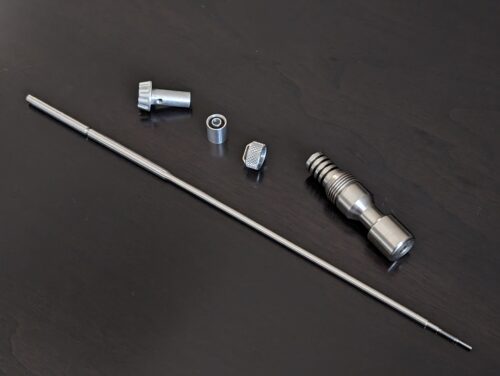Among Wagner’s long list of in-house CNC precision machining capabilities is Swiss machining. This specialized CNC turning process is often used to manufacture parts with small diameters (1.25” or smaller) and long length-to-diameter ratios. However, there are many benefits to using Swiss machining instead of a standard lathe for more conventional turned parts as well.
Here, we’ll explore our history of providing CNC Swiss machining services and the advantages of working with our shop for parts that could benefit from this capability.
Manufacturing Parts with Long Length-to-Diameter Ratios
In 2002, we had a customer who enlisted our production machine shop for a family of parts with long length-to-diameter ratios.
We began making those parts on our conventional lathes, but the process was slow, and we had to perform an additional manual deburring operation due to the intricate part geometry. Because the quantity of parts was so high, we were wasting serious time on both the machining process and the manual deburring, so we decided to invest in the right equipment to produce the parts at high volumes.

The unique addition of a guide bushing to support material is what makes Swiss machines ideal for parts with long length-to-diameter ratios, and it seemed like the obvious choice for this project. Unlike a conventional lathe where the tool moves axially along the length of the part, the material on a Swiss machine is pushed through the guide bushing and past the tool that is less than .060” away from the bushing. This provides consistent support and rigidity for the material right next to the cutting tool and ensures excellent finishes and tolerances regardless of part length.
When we started using a CNC Swiss machine to manufacture this customer’s parts, we saw immediate benefits. We were able to run at a higher RPM and feed rate, and the separate sub spindle tooling allowed us to work on the front and back of a part at the same time. This led to a cycle time reduction of over 50% with no manual deburring, better finishes, tighter tolerances and improved tool life!
Those were huge wins right off the bat for this specific project, but we would soon find that the benefits of Swiss machining extended to many of our more conventional turned parts with standard length-to-diameter ratios, too.
Reducing Cycle Times for Standard Lathe Parts with CNC Swiss Machining
As soon as our initial project was up and running, we immediately started looking for opportunities to apply the advantages of sub-spindle machining to other parts. We were hooked on the reduced cycle time, tight tolerances, and back end machining that created a “done in one” machining process”. The big problem was that running through a bushing required more expensive material that was ground or otherwise processed to a tighter tolerance than standard bar. For many parts, that additional cost was greater than the time savings.
The solution was running Swiss machines in “chucker” mode without a guide bushing. With this option, material is not run through a bushing for support, which allows the use of standard material. When running in chucker mode, the machining process is more like a conventional lathe and can only be used for parts with more reasonable length-to-diameter ratios, but you still have all the other advantages of swiss machining. Today, we have 10 Swiss machines in our facility, and about 75% of the work we do on these machines is for parts with standard length-to-diameter ratios.
You might be thinking, “Aren’t there twin-spindle, twin-turret lathes that allow you to machine the front and back side of the part in the same process?” While it’s true that there are conventional lathes with this functionality (we also have those), they are much larger and slower which makes them poorly suited for machining many smaller parts. Specifically, the time it takes to transfer the part from the main spindle to the sub-spindle on a conventional lathe is substantially longer than it is on a Swiss screw machine.
We have certain parts where the entire cycle time on a Swiss machine is shorter than just the sub-spindle transfer time on a conventional lathe.
Live Tooling and 5-Axis Capabilities
Live tooling, which enables machining of milled features is a common option on Swiss machines and further contributes to the “done in one” benefit of the process. The Swiss machine we purchased for that first project back in 2002 was also our first lathe with live tooling. That capability allowed our customer to add a new product design that increased demand even more. Over the years this ability has almost completely eliminated the need to run second operations on production turned parts.
Live tooling isn’t just for simple milled features either. Some of our “lathe” parts now have more milled features than turned features. Since the process is fast and automated, it is often more efficient than running on a CNC mill. One of our Swiss machines can even do 5-axis milling. In fact, this technically complex machine has nine axes that can be controlled simultaneously! And our 5-axis mill machinists thought lathes were “boring”…
Selecting the Right Capability for Your Parts
Because Wagner offers standard CNC turning and Swiss machining services in-house, we have the opportunity to review each part to determine the best process, and that isn’t always obvious. We will recommend the best process based on material type, tolerances, tooling, and other requirements.
Investing in CNC Swiss machining capabilities over the years is just one example of our commitment to offering versatile in-house solutions to our customers. If you have a part that you think could benefit from Swiss machining, request a quote!
